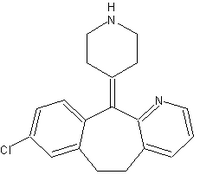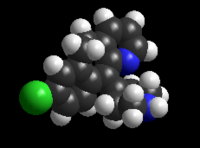Clarinex
(desloratadine, Schering-Plough)
A long-acting tricyclic histamine antagonist for the relief of nasal and nonnasal symptoms of perennial and seasonal allergic rhinitis in people aged 12 and older. Also approved for the symptomatic relief of pruritus and reduction of hives in patients with chronic idiopathic urticaria in the same age group. This is an active metabolite of loratadine (Claritin), which--with the exception of perennial allergic rhinitis--is approved for the same indications in people aged 2 years and older.
* Recommended Dosage: 5 mg once a day. A starting dose of 5 mg every other day is recommended for patients with liver or renal impairment.
* Special Considerations: Like Claritin, Clarinex appears to be a benign medication with a high therapeutic index, said Dr. Eli Meltzer, chair of the American Academy of Allergy, Asthma, and Immunology's pharmacotherapeutics committee. Absorption not affected by food, including grapefruit juice; no interactions with erythromycin or ketoconazole have been observed.
* Comment: In placebo-controlled studies, Clarinex was found to significantly reduce symptoms of seasonal and perennial allergic rhinitis. In two 4-week studies of almost 1,000 patients aged 15-75 with asthma and seasonal allergic rhinitis, those treated with Clarinex had improvements in rhinitis symptoms, with no decrease in pulmonary function. This "supports the safety" of Clarinex in adults with both conditions, according to the drug's labeling. In two placebo-controlled studies of patients with chronic idiopathic urticaria, Clarinex reduced the severity of pruritus, the number of hives, and size of the largest hive, according to the labeling.
There are no approved claims for its comparability with other antihistamines, including Claritin, and in announcing the product's approval, the company did not make any claims about its superiority.
Clarinex was not compared directly with Claritin or other antihistamines in trials, but in vivo and in vitro evidence shows that Clarinex binds better to [H.sub.1] receptors than Claritin, said Dr. Meltzer, an investigator in some of the trials. He is codirector of the Allergy and Asthma Medical Group and Research Center in San Diego.
Clarinex "is a very good [H.sub.1] receptor antagonist and has a long half-life, so it can clearly be used once a day," he said. Most of the other available antihistamines effectively treat perennial allergic rhinitis, although they are not approved for this indication, he noted. Zyrtec (cetirizine) also is approved for perennial allergic rhinitis.
Clarinex "is a little less expensive" than Claritin, said Dr. Meltzer, who is a consultant to Schering-Plough and is on the company's speakers' bureau. Studies of Clarinex in patients younger than age 12 are underway, according to the company.
Procleix HIV-1/HCV Assay
(Gen-Probe and Chiron)
A nucleic acid amplification test (NAT) system for screening whole-blood donors for HIV-1 and hepatitis C virus (HCV) simultaneously The system detects these viruses at the very early stages of infection before antibodies or viral antigens appear. This is the first nucleic acid test system approved by the Food and Drug Administration for use in screening donated blood and blood components intended for transfusions; other tests are being developed.
* Comment: The use of this test "is expected to further ensure the safety of whole blood and blood components, including red cells, fresh plasma, and platelets, by permitting earlier detection of HIV and HCV in donors," the FDA said in a statement. Because the system detects viral genes, instead of antibodies or antigens, these viruses can be detected earlier in the course of infection, the statement noted.
Currently, blood and plasma donors are tested for HCV antibodies, and for HIV antibodies and antigens, but a window period remains in which a donor can be infected with these viruses but have negative screening tests. In its statement, the FDA said that the use of this system to detect HCV reduces this window by about 57 days, from an average of 82 days to 25 days. For HIV-1, the use of this system reduces the window to about 12 days, compared with about 16 days with antigen testing. (The average window period for HIV-1 with antibody testing is 22 days.)
In U.S. studies of the system, 7 HIV-1-positive and 88 HCV-positive donations were detected in more than 20 million donations tested, according to Chiron.
COPYRIGHT 2002 International Medical News Group
COPYRIGHT 2002 Gale Group



